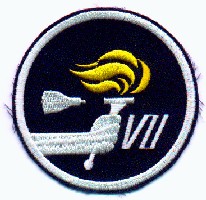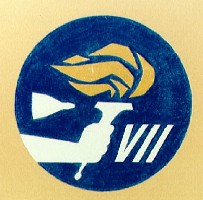

Crew & Mission
Astronauts Frank Borman and James A. Lovell,Jr., were selected as primecrew for the Gemini-VII mission on July 01, 1965. The back-up crew members were, Edward H. White and Micheal Collins.
Gemini-VII, a 14-day long mission, was primarily designed to conduct long duration flight and to evaluate the effects on the crew. In addition, they provided a target for Gemini-VI-A, and conducted station keeping with the Gemini-VI-A spacecraft. The crew performed some 20 experiments during the mission. The crew wore lightweight pressure suits during the flight, a first.
Gemini-VII was launched from Cape Kennedy at 2:30:03 pm EST, December 04, 1965. During the flight, Gemini-VII attained a maximum apogee of 177.1 miles and a low perigee of 87.2 miles. Lovell removed his pressure suit on the second day in orbit, and from that time until the end of the flight either one or both of the crewmen were out of their suits most of the time.
Landing of the Gemini-VII spacecraft came on December 18, 1965, In the western Atlantic recovery zone, just 6.4 miles from the planned landing point at 9:05:34 am EST, after a flight which had lasted 330 hours, 35 minutes, and 1 second. The USS Wasp recovered the second crew of Gemini astronauts within a three-day period. Borman and Lovell went aboard the USS Wasp in a helicopter at 9:37 am, and their spacecraft was taken aboard at 10:08 am. The total elapsed time of the flight was about twice that anticipated necessary for a lunar landing mission.
A Personal Story
"Gemini-7 was to be a two week mission with mostly medical experiments being conducted. Therefor, we wanted an insignia that would signify medicine and endurance, much like a long distance runner. We chose the torch as the emblem. If you notice, the torch seems to be in motion signifying the flight of Gemini-7 over a long period of time. The artwork on the Gemini-7 patch was done by NASA Artist."
Astronaut Jim Lovell in "All we did was fly to the moon"
The Artwork

The Gemini-7 astronauts designed their patch with these aims in mind and the result was a mission emblem wich symbolised endurance. The two-week mission was compared to a long distance runner and so the astronauts chose the Olympic torch grasped by a hand as the central feature on the patch. The curling flame of the torch makes it appear to be in motion and this signifies the extended duration aspect of the flight. The gemini spacecraft is located on the left side of the patch with the roman numerals VII on the right.
Souvenir
Some souvenir versions of this patch include the names of the crew, but these were not present on the patches the crew wore during the flight. The patch was located on the upper right sleeve of each suit.